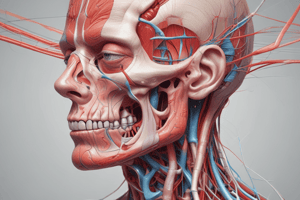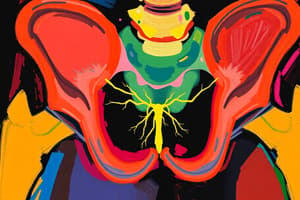Podcast
Questions and Answers
Which of the following membrane potential changes does NOT directly contribute to initiating an action potential?
Which of the following membrane potential changes does NOT directly contribute to initiating an action potential?
- Isopotential
- Reversal of polarity
- Latent period
- Hyperpolarization (correct)
A nerve fiber has a resting membrane potential (RMP) of -70 mV and a firing level of -50 mV. Under which of the following membrane potentials would this nerve fiber be LEAST excitable?
A nerve fiber has a resting membrane potential (RMP) of -70 mV and a firing level of -50 mV. Under which of the following membrane potentials would this nerve fiber be LEAST excitable?
- -60 mV
- -30 mV
- -70 mV (correct)
- -55 mV
Electrotonic potentials and local responses share several characteristics. Which of the following statements is INCORRECT regarding these potentials?
Electrotonic potentials and local responses share several characteristics. Which of the following statements is INCORRECT regarding these potentials?
- They are graded responses.
- They are local (non-propagated) responses.
- They may be depolarizing or hyperpolarizing.
- They are produced by a threshold stimulus. (correct)
Which of the following scenarios is MOST likely to decrease nerve excitability?
Which of the following scenarios is MOST likely to decrease nerve excitability?
During muscle relaxation, which protein directly blocks the myosin-binding sites on actin filaments?
During muscle relaxation, which protein directly blocks the myosin-binding sites on actin filaments?
During an isometric contraction of skeletal muscle, which of the following is observed?
During an isometric contraction of skeletal muscle, which of the following is observed?
Muscle fatigue is associated with the accumulation of which of the following metabolites?
Muscle fatigue is associated with the accumulation of which of the following metabolites?
Which of the following statements about the sarcomere is INCORRECT?
Which of the following statements about the sarcomere is INCORRECT?
Which of the following muscles' tendons does NOT directly contribute to the plantar aspect of the foot?
Which of the following muscles' tendons does NOT directly contribute to the plantar aspect of the foot?
Which artery listed below typically does not participate in the anastomosis around the anterior superior iliac spine (ASIS)?
Which artery listed below typically does not participate in the anastomosis around the anterior superior iliac spine (ASIS)?
The peroneal artery branches directly from which of the following arteries?
The peroneal artery branches directly from which of the following arteries?
Which of the following characteristics is most indicative of chondroblasts?
Which of the following characteristics is most indicative of chondroblasts?
Elastic cartilage is found in the epiglottis and ear pinna, but only one of the following cartilage types is not surrounded by a perichondrium. Which is it?
Elastic cartilage is found in the epiglottis and ear pinna, but only one of the following cartilage types is not surrounded by a perichondrium. Which is it?
Which bone cell type is primarily responsible for the process of bone remodeling?
Which bone cell type is primarily responsible for the process of bone remodeling?
Using electron microscopy (EM), which bone cells are observed to be connected by gap junctions, facilitating direct cell-to-cell communication?
Using electron microscopy (EM), which bone cells are observed to be connected by gap junctions, facilitating direct cell-to-cell communication?
Regarding the organic component of bone matrix, which statement accurately describes its characteristics?
Regarding the organic component of bone matrix, which statement accurately describes its characteristics?
Damage to the obturator nerve would most significantly impair which lower limb movement?
Damage to the obturator nerve would most significantly impair which lower limb movement?
Which of the following characteristics is unique to only one of the hamstring muscles?
Which of the following characteristics is unique to only one of the hamstring muscles?
A stab wound to the gluteal region results in loss of sensation in the perineum. Which structure was MOST likely damaged?
A stab wound to the gluteal region results in loss of sensation in the perineum. Which structure was MOST likely damaged?
Following a motorcycle accident, a patient exhibits reduced blood flow to the adductor muscles of the thigh. Which artery is MOST likely affected?
Following a motorcycle accident, a patient exhibits reduced blood flow to the adductor muscles of the thigh. Which artery is MOST likely affected?
A patient is unable to evert their foot and has difficulty with plantarflexion. Which nerve is MOST likely damaged?
A patient is unable to evert their foot and has difficulty with plantarflexion. Which nerve is MOST likely damaged?
A patient complains of groin pain and weakness in hip flexion. Imaging reveals compression of a nerve as it passes along the lateral border of the psoas major. Which nerve is MOST likely compressed?
A patient complains of groin pain and weakness in hip flexion. Imaging reveals compression of a nerve as it passes along the lateral border of the psoas major. Which nerve is MOST likely compressed?
An athlete experiences pain along the anterior aspect of their lower leg and weakness in dorsiflexion and inversion. Which statement BEST describes the injury?
An athlete experiences pain along the anterior aspect of their lower leg and weakness in dorsiflexion and inversion. Which statement BEST describes the injury?
A surgeon is ligating the femoral artery within the adductor canal. Which structure is LEAST likely to be at risk during this procedure?
A surgeon is ligating the femoral artery within the adductor canal. Which structure is LEAST likely to be at risk during this procedure?
Flashcards
Chondroblasts
Chondroblasts
Cells that produce cartilage and maintain its matrix, forming isogenous groups.
Osteoclast
Osteoclast
Bone cells responsible for bone remodeling by resorbing bone tissue.
Haversian System
Haversian System
The structural unit of compact bone, containing blood vessels and osteocytes.
Perichondrium
Perichondrium
Signup and view all the flashcards
Endomysium
Endomysium
Signup and view all the flashcards
Intercalated Discs
Intercalated Discs
Signup and view all the flashcards
Smooth Muscle Fibers
Smooth Muscle Fibers
Signup and view all the flashcards
Skeletal Muscle Nuclei
Skeletal Muscle Nuclei
Signup and view all the flashcards
Resting Membrane Potential (RMP)
Resting Membrane Potential (RMP)
Signup and view all the flashcards
Threshold Potential
Threshold Potential
Signup and view all the flashcards
Electrotonic Potentials
Electrotonic Potentials
Signup and view all the flashcards
Tropomyosin
Tropomyosin
Signup and view all the flashcards
Isometric Contraction
Isometric Contraction
Signup and view all the flashcards
Muscle Fatigue
Muscle Fatigue
Signup and view all the flashcards
Sarcomere
Sarcomere
Signup and view all the flashcards
Plasticity of Smooth Muscle
Plasticity of Smooth Muscle
Signup and view all the flashcards
Obturator nerve function
Obturator nerve function
Signup and view all the flashcards
Muscles of the back of the thigh
Muscles of the back of the thigh
Signup and view all the flashcards
Structures passing through sciatic foramen
Structures passing through sciatic foramen
Signup and view all the flashcards
Femoral artery branches
Femoral artery branches
Signup and view all the flashcards
Peroneus longus
Peroneus longus
Signup and view all the flashcards
Psoas major muscle
Psoas major muscle
Signup and view all the flashcards
Tibialis anterior muscle
Tibialis anterior muscle
Signup and view all the flashcards
Structures in the adductor canal
Structures in the adductor canal
Signup and view all the flashcards
Study Notes
Exam Instructions
- All questions are mandatory
- The exam consists of 120 multiple-choice questions (MCQs)
- Answers are to be marked on a bubble sheet
- Select the best answer for each question
Musculoskeletal System Exam Questions
-
Question 1: The obturator nerve supplies the following muscle:
- adductor magnus
- obturator internus
- quadratus femoris
- sartorius
-
Question 2: One true statement about the muscles of the back of the thigh:
- All extend the knee
- All are inserted into the tibia
- All arise from the ischial spine
- All are supplied by the sciatic nerve
-
Question 3: Which structure passes from the greater to the lesser sciatic foramen?
- The sciatic nerve
- The pudendal nerve
- The posterior cutaneous nerve of the thigh
- The nerve to obturator externus
-
Question 4: A branch of the femoral artery:
- deep circumflex iliac artery
- deep external pudendal artery
- circumflex fibular artery
- middle genicular artery
-
Question 5: A true statement about the peroneus longus muscle:
- It inserts into the base of the 5th metatarsal
- It has a broad tendon behind the medial malleolus
- It is supplied by the superficial peroneal nerve
- It arises from the upper two-thirds of the tibia
-
Question 6: A true statement about the psoas major muscle:
- The lateral cutaneous nerve of the thigh appears along its lateral border
- It is a powerful lateral rotator of the femur
- It inserts into the greater trochanter
- It arises from the iliac crest and sacroiliac joint
-
Question 7: A true statement about the tibialis anterior muscle:
- It is supplied by the tibial nerve
- It inserts into the second metatarsal bone
- It dorsiflexes and inverts the foot
- It does not arise from the interosseous membrane
-
Question 8: Which structure is NOT found in the adductor canal?
- femoral artery
- femoral nerve
- femoral vein
- nerve to vastus medialis
-
Question 9: Which structure passes superficially to the superior extensor retinaculum at the ankle?
- Extensor digitorum longus
- Deep peroneal nerve
- Anterior tibial artery
- Superficial peroneal nerve
-
Question 10: A true statement about the anterior cruciate ligament:
- It lies within the synovial membrane of the knee joint
- It attaches from the anterior intercondylar area of the tibia to the medial condyle of the femur
- It prevents forward displacement of the femur on the tibial surface
- It becomes tense in full extension
-
Question 11: Which muscle is not found in the floor of the femoral triangle?
- Psoas major
- Pectineus
- Adductor magnus
- Adductor longus
-
Question 12: A true statement about the gluteus maximus:
- It is a powerful lateral rotator of the thigh
- The whole muscle inserts into the lateral lip of the linea aspera
- It is supplied by the superior gluteal nerve
- It arises from the inner lip of the iliac crest
-
...and so on (additional questions are in the provided text)
Studying That Suits You
Use AI to generate personalized quizzes and flashcards to suit your learning preferences.




